Intricate Forged Locks

The locksmiths of centuries past were often highly esteemed by the metal tradesmen, and some regarded them as the epitome of metalworkers. The locks I will present today will show why the locksmiths held such a lofty position in Europe. You could say they were the master’s master of metalworkers.
These are locks that I have cleaned over the years for my clients.
The image above, and below (same lock) are examples of not only a keen command of the material, but also an acute awareness of mechanics.
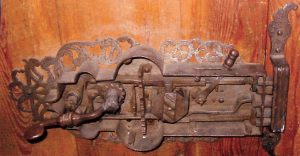
To put this into better perspective, this lock is about 12″ long. This lock is missing its cover, which is to your benefit, as you can easily see the working parts. Note also the fine patina on the handle from decades of use.
Below is another lock of about the same proportions.
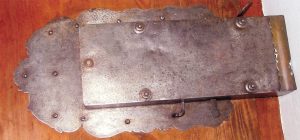
If you click on any of these images you will get an enlargement of the image. Clicking on the enlargement will get you an even larger image. I encourage you to do so as you will then see the details not so visable in the images on this page.
For instance, this lock has been acid etched to produce an intricate design on the surface of the lock….not easily seen unless the image is enlarged. Time has erased much of the etching, but some of the details still remain. The lock images below are a finer example of this acid etching.
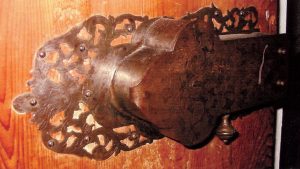

The pattern was produced by carefully painting the surface with a paste that would inhibit the acid. Where there was no paste, the acid would eat away at the metal, producing not only a form of relief, but also a color variation.
Note also the intricate designs in the negative space, (often referred to as “open work“) or where metal has been removed by piercing, sawing, and finish filing. In the lock above, the locksmith also did some mild repoussé, by bumping up the material from behind, creating a more three dimensional form. Patience is evident in every aspect of these intricate works of metal mastery.
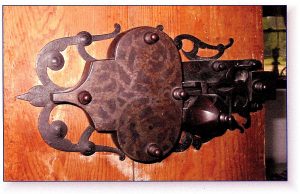
The lock above was also etched, and note the fine faceted ward cover. The open work is exceptional in this piece as well.
Below is a fine smaller lock of about 6″ long. Please forgive the blurry image, but the form is so refined, I had to include it in this dialogue.
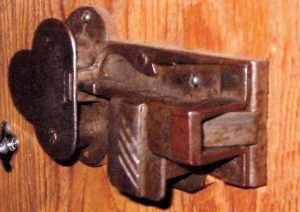
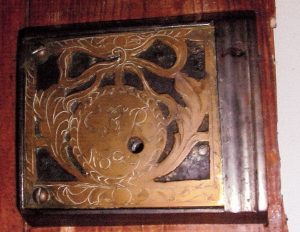
The above image is a brass and iron version, where the brass contrasts nicely with the iron behind it. The locksmith greets us with the year the lock was made (1899), which is unusual for any type of metalwork. The image below is of an even earlier piece, made in 1889.
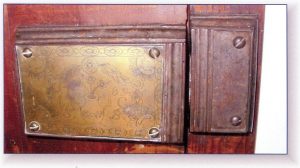
I am not certain as to whether the initials are representitive of the client, or the locksmith that made the piece.
Below are examples of the compliments to the locks, i.e. the handles, and escutheons on the opposite side of the doors.
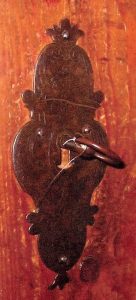
Note that these were sometimes engraved with intricate patterns, again showing the prowess of the locksmith.

Lastly, we see a finely engraved keyhole escutcheon, and an exceptinal handle.

Please lock up before you leave the blog…..thanks!
…….Dan Nauman
“Work is a necessity for man. Man invented the alarm clock.” …..Pablo Picasso, Artist.
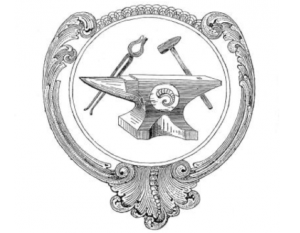
3 comments to “Intricate Forged Locks”
Dave Inlay - March 1, 2010
I have a very old lock and hinges possible 15/16th century German I have been researching. Would I be able to send images to you for your opinion??
any help appriciated.
bighornforge - March 2, 2010
Hello Dave,
Yes, I can take a look at them. E-mail me at bighornforge@verizon.net and send an attachment…….Dan
Dave Inlay - March 2, 2010
Thank you Dan, pics are on the way. I have had this set for quite a few years, first time i researched was w/out the internet. i had send photos to detroit Museum of Art. At first I was told they were marine, but knew that was wrong being made of iron. Very hard item to appraise.
In doing research I have become interested in locks. I repair time clocks, specializing in restoring old ones,so locks are a natural.
dave